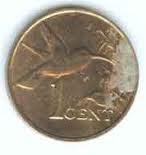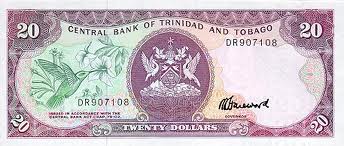|


The dollar (currency code TTD) is the currency of Trinidad and Tobago. It is normally abbreviated with the dollar sign $, or alternatively TT$ to distinguish it from other dollar-denominated currencies. It is subdivided into 100 cents. Its predecessor currencies are the Trinidadian dollar and the Tobagan dollar.
History
The history of currency in the British colony of Trinidad and Tobago closely follows that of the British Eastern Caribbean territories in general. Even though Queen Anne's proclamation of 1704 brought the gold standard to the West Indies, silver pieces of eight (Spanish dollars and later Mexican dollars) continued to form a major portion of the circulating currency right into the latter half of the nineteenth century.
Britain adopted the gold standard in 1821 and an imperial order-in-council of 1838 resulted in Trinidad and Tobago formally adopting the sterling currency. However, despite the circulation of British coins in Trinidad and Tobago, the silver pieces of eight continued to circulate alongside them. The international silver crisis of 1873 signalled the end of the silver dollar era in the West Indies and silver dollars were demonetized in Tobago in 1879 and in Trinidad at around the same period. This left a state of affairs, in which the British coinage circulated, being reckoned in the private sector using dollar accounts at an automatic conversion rate of 1 dollar = 4 shillings 2 pence. Government offices kept their accounts in British pounds, shillings, and pence until the year 1935 when Trinidad and Tobago went decimal.
From 1949, with the introduction of the British West Indies dollar, the currency of Trinidad and Tobago became officially tied up with that of the British Eastern Caribbean territories in general. The British sterling coinage was eventually replaced by a new decimal coinage in 1955, with the new cent being equal to one half of the old penny. In 1951, notes of the British Caribbean Territories, Eastern Group, were introduced, replacing Trinidad and Tobago's own notes. In 1955, coins were introduced when the dollar was decimalized. In 1964, Trinidad and Tobago introduced its own dollar, replacing the East Caribbean dollar at par. The Trinidad and Tobago dollar and the Eastern Caribbean dollar were the last two currencies in the world to retain the old rating of one pound equals four dollars and eighty cents, as per the gold sovereign to the Pieces of eight. Both of these currencies ended this relationship within a few weeks of each other in 1976.
For a wider outline of the history of currency in the region, see Currencies of the British West Indies.
Coins
In 1966, coins were introduced in denominations of 1¢, 5¢, 10¢, 25¢ & 50¢. A large sized $1 coin was first released for circulation in 1969 and again in 1979 before being replaced with a smaller sized version in 1995 more regularly minted. The 1¢ & 5¢ are struck in bronze, with the other denominations in cupro-nickel. The obverses all feature Trinidad and Tobago's coat of arms, with the reverse designs solely featuring the denomination until 1976, when they were replaced by either a national bird or flower in addition to the denomination after the declaration of a republic. The 50¢ & $1 coins are scarcely seen in circulation.
Banknotes
In 1898, the Colonial Bank introduced $20 notes. These were followed in 1901 by $5. $100 notes were also issued. The last notes were issued in 1926, after which the Colonial Bank was taken over by Barclays Bank, which issued $5, $20 & $100 notes until 1941.
In 1905, notes were introduced by the government in denominations of $1 & $2, followed by $5 in 1935, followed by $10 & $20 in 1942.
The Royal Bank of Canada introduced $5, $20 & $100 notes in 1909. From 1920, the notes also bore the denomination in sterling . 100-dollar notes were not issued after 1920, whilst the $5 and $20 were issued until 1938. The Canadian Bank of Commerce introduced $5, $20 & $100 notes in 1921, with the $5 & $20 notes issued until 1939.
In 1964, the Central Bank of Trinidad and Tobago introduced notes for $1, $5, $10 & $20. $50 & $100 notes were issued in 1977, although the $50 note was not continued. The reverses of the current notes feature the Central Bank Building of Trinidad & Tobago. The obverses have the coat of arms in the center, a national bird and a place in Trinidad, such as a market, petroleum refinery, etc. In 2002, new $1 & $20 notes were introduced. In 2003, new $1, $5, $10 & $100 were also introduced. The notes were only slightly changed; they now have more security features & darker color. Recently, more security features have been added to the notes by the Central Bank of Trinidad and Tobago.
Banknotes in circulation are
* $1 (red)
* $5 (green)
* $10 (grey)
* $20 (purple)
* $100 (blue)
The text on this page has been made available under the Creative Commons Attribution-ShareAlike License and Creative Commons Licenses
|
